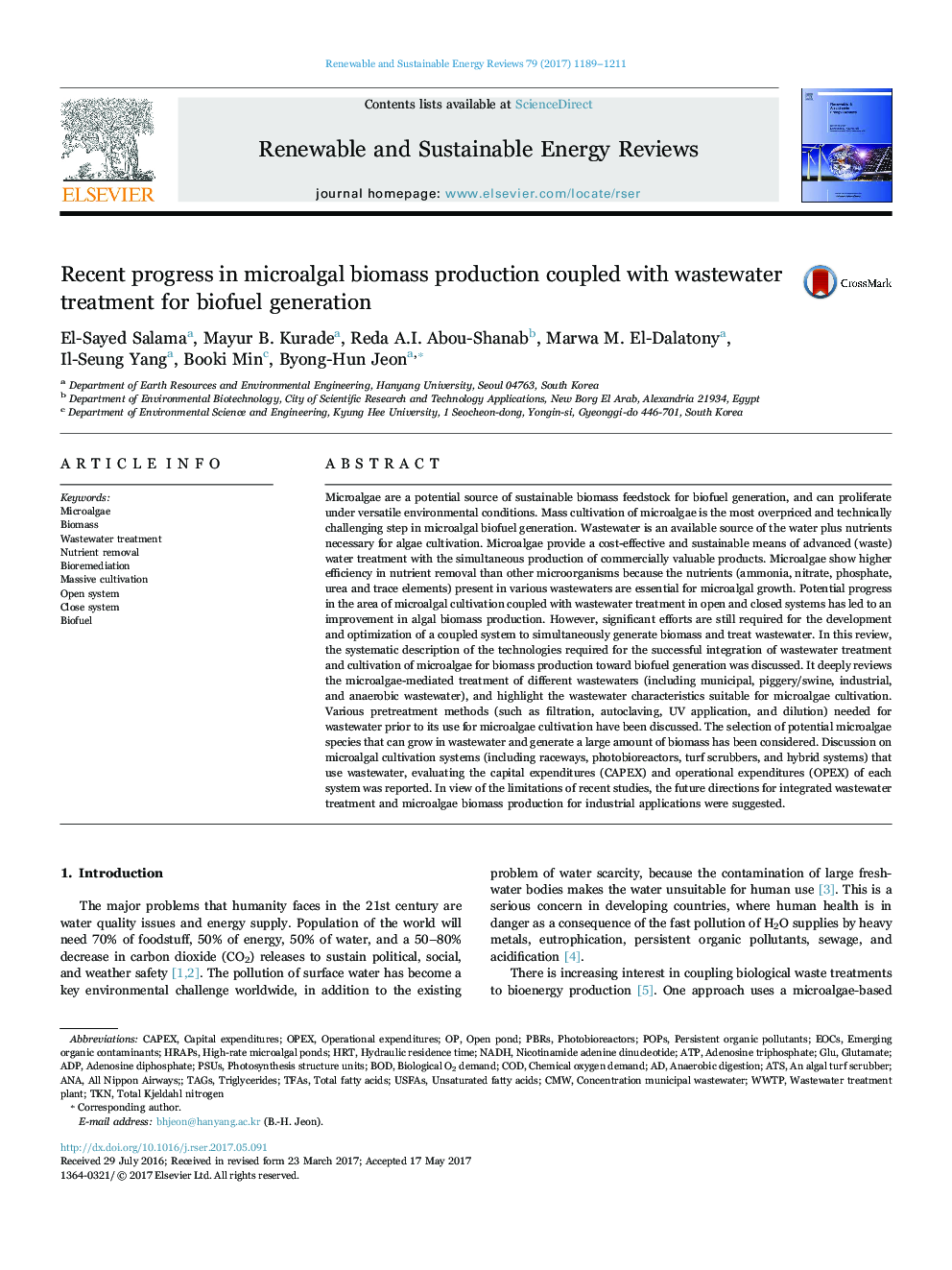| کد مقاله | کد نشریه | سال انتشار | مقاله انگلیسی | نسخه تمام متن |
|---|---|---|---|---|
| 5482631 | 1522307 | 2017 | 23 صفحه PDF | دانلود رایگان |
عنوان انگلیسی مقاله ISI
Recent progress in microalgal biomass production coupled with wastewater treatment for biofuel generation
ترجمه فارسی عنوان
پیشرفت اخیر در تولید زیست توده میکروالگال همراه با درمان فاضلاب برای تولید سوخت های زیستی
دانلود مقاله + سفارش ترجمه
دانلود مقاله ISI انگلیسی
رایگان برای ایرانیان
کلمات کلیدی
CMWPhotobioreactorsTKNHRTCAPEXBODADPATSTFAsPBRsWWTPOPEXAdenosine Triphosphate - آدنوزین تری فسفاتATP - آدنوزین تری فسفات یا ATPadenosine diphosphate - آدنوزین دی فسفاتEmerging organic contaminants - آلاینده های آلی در حال ظهورPOPs - آلایندههای آلی دیرپاPersistent organic pollutants - آلایندههای آلی دیرپا(پایدار)Unsaturated fatty acids - اسیدهای چرب غیر اشباعANA - اصلیTAGs - برچسب هاTriglycerides - تریگلیسریدWastewater treatment plant - تصفیه خانه فاضلاب Wastewater treatment - تصفیه فاضلابchemical oxygen demand - تقاضای اکسیژن شیمیاییNutrient removal - حذف مواد مغذیOpen pond - حوضچه بازMicroalgae - ریز جلبک هاhydraulic residence time - زمان اقامت هیدرولیکBiomass - زیست توده یا بیومسBioremediation - زیست پالاییBiofuel - سوخت های زیستیOpen system - سیستم بازNADH - نادانNAD, nicotinamide adenine dinucleotide - نیکوتینامید آدنین دینوکلئوتیدcapital expenditures - هزینه های سرمایهOperational expenditures - هزینه های عملیاتیAnaerobic digestion - هضم بیهوازیCod - کادوTotal fatty acids - کل اسیدهای چربtotal Kjeldahl nitrogen - کل نیتروژن KjeldahlGlu - گلوglutamate - گلوتامات
موضوعات مرتبط
مهندسی و علوم پایه
مهندسی انرژی
انرژی های تجدید پذیر، توسعه پایدار و محیط زیست
چکیده انگلیسی
Microalgae are a potential source of sustainable biomass feedstock for biofuel generation, and can proliferate under versatile environmental conditions. Mass cultivation of microalgae is the most overpriced and technically challenging step in microalgal biofuel generation. Wastewater is an available source of the water plus nutrients necessary for algae cultivation. Microalgae provide a cost-effective and sustainable means of advanced (waste)water treatment with the simultaneous production of commercially valuable products. Microalgae show higher efficiency in nutrient removal than other microorganisms because the nutrients (ammonia, nitrate, phosphate, urea and trace elements) present in various wastewaters are essential for microalgal growth. Potential progress in the area of microalgal cultivation coupled with wastewater treatment in open and closed systems has led to an improvement in algal biomass production. However, significant efforts are still required for the development and optimization of a coupled system to simultaneously generate biomass and treat wastewater. In this review, the systematic description of the technologies required for the successful integration of wastewater treatment and cultivation of microalgae for biomass production toward biofuel generation was discussed. It deeply reviews the microalgae-mediated treatment of different wastewaters (including municipal, piggery/swine, industrial, and anaerobic wastewater), and highlight the wastewater characteristics suitable for microalgae cultivation. Various pretreatment methods (such as filtration, autoclaving, UV application, and dilution) needed for wastewater prior to its use for microalgae cultivation have been discussed. The selection of potential microalgae species that can grow in wastewater and generate a large amount of biomass has been considered. Discussion on microalgal cultivation systems (including raceways, photobioreactors, turf scrubbers, and hybrid systems) that use wastewater, evaluating the capital expenditures (CAPEX) and operational expenditures (OPEX) of each system was reported. In view of the limitations of recent studies, the future directions for integrated wastewater treatment and microalgae biomass production for industrial applications were suggested.
ناشر
Database: Elsevier - ScienceDirect (ساینس دایرکت)
Journal: Renewable and Sustainable Energy Reviews - Volume 79, November 2017, Pages 1189-1211
Journal: Renewable and Sustainable Energy Reviews - Volume 79, November 2017, Pages 1189-1211
نویسندگان
El-Sayed Salama, Mayur B. Kurade, Reda A.I. Abou-Shanab, Marwa M. El-Dalatony, Il-Seung Yang, Booki Min, Byong-Hun Jeon,
